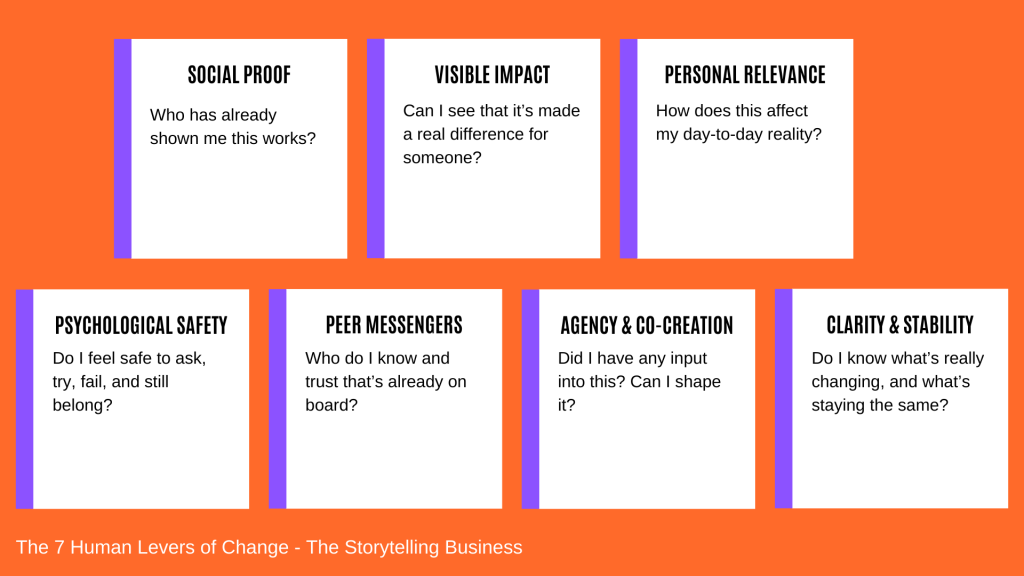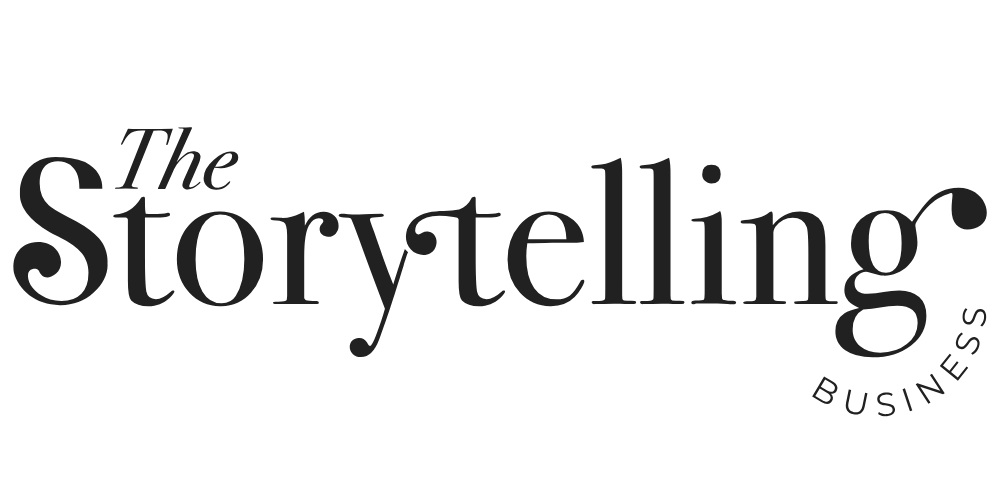When you understand the psychological drivers behind a change mindset, you can use storytelling more strategically; not as the goal, but as a tool for building real engagement.
The 7 Levers of Human Change
At The Storytelling Business, we work from an understanding of seven levers of human change. These levers are curated from a range of leading change management sources, including research published by Deloitte, and founder Michelle Newell’s own experience of working in change management for 8 years in the UK.
Effective change occurs when it’s reframed from ‘getting people on board’ to ‘how do we make people feel like they matter in this, and are part of what’s next?’. In order to do that, it’s important to understand the psychological and strategic dimensions of human change. This entails cultivating a human-centred approach to change (where your people, rather than leadership, are the humans at the heart of any change process).

Why most change storytelling misses the mark
Change leaders are told they need to “tell stories” to get people on board. But in a change process, storytelling on its own doesn’t move people. Project vision stories often fail to garner enthusiasm from staff because they are told from the perspective of the organisation, or the client/customer is made the ‘hero’ of the story. How can staff see themselves in this narrative? They can’t – and they switch off.
How to Use Story to Activate the 7 Levers of Human Change
During change, storytelling only works when it’s treated as a device that switches on the real levers of change. Here’s how stories can play their part in your change toolkit, to activate those all important psychological and strategic needs of your people.
1. People need Social Proof to change
People move when people like them move. Not when leaders make announcements. Not when posters go up in the kitchen. The moment Tanya from Payroll tries the new system and says, “Honestly, it’s made my life easier,” is the moment when momentum kicks in.
Story Lesson: Story is how social proof travels. A well-told peer experience builds trust faster than any FAQ.
2. People need to witness Visible Impact to change
Engagement rises when people can see tangible results. And these results cannot just be metrics or dashboards. They need to witness actual shifts in their experience, workload, or outcomes.
Story Lesson: Story dramatises impact. It turns “we saved time” into “now I can pick my kid up from school.”
3. People change when they find Personal Relevance
No one cares about “the transformation journey” if they can’t see their place in it. The key question people are asking of you as their leader is: “What does this mean for me?”
Story Lesson: Story creates mirrors. When you tell stories that reflect people’s roles, fears, and hopes, you invite them into the change.
4. Psychological Safety is essential for change to occur
People won’t adopt changed behaviours if it feels like a test. They need room to try, mess up, ask questions, and still feel safe.
Story Lesson: Story normalises uncertainty. “We got it wrong at first too” is more powerful than “Here’s the 12-step process you need to follow.”
5. Peer Messengers Matter more than Leaders during Change
People listen more closely to those they relate to. That’s why top-down messaging often lands flat. Credibility travels sideways.
Story Lesson: Lower the volume on your leader-perspective stories. Activate your change champions as genuine storytellers.
6. Change needs Agency and Co-Creation
You don’t get buy-in by asking people to ‘align with the vision’. You get it by involving them in shaping that vision, and playing back how their input mattered.
Story Lesson: Story gives credit where it’s due. Shared ownership creates deeper commitment.
7. People crave Clarity and Stability during change
In times of change, people don’t just want to know what’s new. They also want to know what isn’t changing. What will stay familiar? What can they still count on?
Story Lesson: Story helps orient people. A clear narrative gives them a mental map: what’s shifting, what’s staying put, and where we’re heading together.
Tell Change Stories at the Right Moments, for the Right Reasons
In any period of change or disruption, leaders should avoid starting their engagement with the question: “How do we tell more stories?”. Instead, they could start by asking: “What do people need to believe, feel, or understand to take the next step?”
Once you’ve understood the psychological starting point of your audience, you can ask the follow up question: “How can story help us do that?” (Yes, we love questions rather than answers a The Storytelling Business!).
Story is only powerful during a change process or times of uncertainty when it’s in service of human investment. When storytelling is used as a tool of sales or coercion, it will always fall flat.
Learn the art of Storytelling for Change with The Storytelling Business
Ready to experience the power of stories in times of change? Michelle offers a Change Leadership Storytelling Session for your team. Please send an email to find out more.



